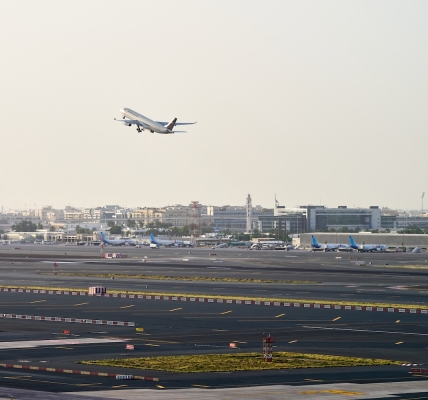Green Airports and Key Sustainability Initiatives
- As the aviation industry faces increasing scrutiny over its environmental impact, the transition to sustainable airports represents a significant step forward.
- These airports prioritise the use of renewable energy sources, such as solar and wind power, and energy-efficient technologies to optimise energy consumption.

Airport Sustainability Initiatives
Go Green’ is now an established protocol for new airports emerging across the world. But mounting climate change concerns have injected a sense of urgency and purpose into this trend. Echoing this, several Indian airports are now accelerating their key sustainability initiatives. Beyond visually striking green architectural tweaks, airport operators have their focus riveted on preserving the biodiversity and natural ecosystems in and around their premises.
In a telling testimony of this spotlight on sustainability, the 19th Airports Council International (ACI) Asia-Pacific & Middle East Regional Assembly in Riyadh had a tough time choosing a winner for its Green Airports Recognition Awards. Airports in the region showcased their compelling environmental initiatives that included wetland restoration and creation, balancing wildlife species with airport operations, prevention of wildlife trafficking, ecosystem restoration and carbon removal through natural means.
From an Indian perspective, the Kempegowda International Airport (KIA) Bengaluru won a silver award for the category of airports handling between 15 million and 35 million passengers per annum. The Mangaluru International Airport won this award in the less than 8 million PPA category for its single-use plastic-free status. As Stefano Baronci, Director-General of ACI Asia-Pacific & Middle East put it, the competition entries demonstrated a range of innovations from marine life conservation, and wetland restoration to wildlife species management.
Sustainability vision
Among the first in the country to adopt a green theme, KIA had stressed its ‘airport in a garden’ concept for its Terminal-2. But the airport’s sustainability vision goes beyond, as Hari Marar, Chief Executive Officer, Bangalore International Airport Limited (BIAL) puts it: “Our vision is brought to life through six guiding pillars — Water Stewardship, Net Zero Carbon Emissions, Community-Aligned Noise Management, Circular Economy, Sustainable Procurement, and Sustainable Mobility.”
To boost green mobility and contribute to the airport’s carbon emission reduction efforts, BIAL introduced a fleet of 175 electric vehicle (EV) Airport Taxis in 2024. “We have upheld our commitment to water positivity by replenishing more water than we consume, resulting in a water positivity index of 2.36. Currently, we are recovering two-thirds of our potable water requirement through rainwater harvesting and are on track to achieve near 100% recovery,” informs Hari.
In Mumbai, the Chhatrapati Shivaji Maharaj International Airport (CSMIA) too has revved up its green initiatives. Currently, CSMIA claims to have achieved 100% green electricity, solar power included. While the airport is transitioning to electric vehicles, vertical green walls have emerged at multiple locations including the terminals and ceremonial lounge. Water conservation systems, rainwater harvesting and wastewater recycling are all part of CSMIA’s green agenda.
Noise monitoring system
Beyond the traditional eco-initiatives, the Mumbai airport operator has also set up a noise monitoring system to capture noise levels and correlate them with aircraft movements. Its Carbon Accounting and Management System (CAMS) is another unique initiative, designed to identify, measure, and manage greenhouse gas emissions.
In June 2024, the Delhi International Airport Limited (DIAL) declared that the airport’s power consumption per passenger had reduced by over 50%. Targeting net zero-emission by 2030, the airport’s power consumption per passenger stood at 5.18kwh in 2010. Currently, it is 2.21kwh, a reduction of 57%.
DIAL attributes this achievement to multiple energy-saving initiatives including green building practices, the use of energy-efficient infrastructure, and ongoing efforts to further optimise consumption. Among the key measures are the use of dedicated automation in complex airport systems such as Heating, Ventilation, and Air Conditioning (HVAC), Baggage Handling System (BHS), Information Technology (IT) and Airside Ground Light (AGL). Also contributing to the overall impact are the use of LED lights and a very high throughput (VHT) system. These are designed to maximise the assets’ performance and optimise energy consumption through real-time monitoring and control.
Thrust on energy efficiency
High solar-reflective roof material, daylight harvesting concept and double glassed façade are part of Delhi airport’s thrust on energy efficiency. Landscaping is designed to reduce the heat island effect and bring down the local climate. To reduce the operational running time, conveyors in baggage handling systems, travellators and escalators are idle-optimised. Airside ground lights and conventional lights have given way to LED illuminations.
In a bid to further reduce its environmental footprint, DIAL has proposed to integrate daylight harvesting in its new terminal infrastructure. To reduce power consumption, the airport also plans to install an advanced Baggage Handling with an integrated cart system, and an advanced high-side chiller system. A 7.45MW solar power plant on the airside is incidentally, the first such facility in an Indian airport.
The GMR Hyderabad Airport too has transitioned to a fully green status. One of the early starters, the airport had announced its intention to be 100 per cent dependent on green energy in 2023. In partnership with the Telangana State Southern Power Distribution Company (TSSPDCL), the airport had sought to harness green energy for both its infrastructure and operations through a hybrid approach: An in-house 10MWp solar power plant and green energy supplied by TSSPDCL.
World’s first green airport
Adjudged as the world’s first ‘green airport,’ the Kochi International Airport has been a front-runner in this field for years. Solar power meets all the airport’s electricity requirements, a feat acknowledged and honoured by the United Nations which bestowed it with the 2018 Champions of Earth award.
The airport had installed the first solar photovoltaic power station plant on the arrival terminal block rooftop in 2013. But this was only a start, as many more solar power units were added to boost energy production. The trend continued leading eventually to the Cochin International Airport Limited (CIAL) declaring that the airport had become power surplus. Power neutrality was achieved way back in 2015.
Globally, the ‘green airport’ trend has diversified further, as tellingly illustrated by the Mactan-Cebu International Airport in the Philippines. Earning recognition for its Coastal Clean-Up project, the airport had stressed on marine preservation, collecting 18 tons of solid waste in consecutive clean-up events spread over three months. This project led to the restoration of mangrove areas, serving as feeding grounds for migratory birds and reducing plastic pollution in the sanctuary’s ecosystem. This was another instance of airports contributing to the battle against climate change.

Likewise, the Hong Kong International Airport has been honoured for its implementation of marine ecology and fisheries enhancement measures. The project encompassed the deployment of artificial reefs that significantly benefitted marine habitats and fisheries resources. It has been reported that this airport-initiated project led to a fivefold increase in recorded marine species.
Retrofitting old airports
While most green-field airports in the country now lay stress on the ‘green’ route, the Airports Authority of India (AAI) has a task for the 137 airports it manages: Retrofitting them with a sustainability boost. Of these airports, 24 are international. Under its Sustainable Green Airports Mission (SUGAM), AAI has started implementing a strategy to minimise carbon emissions at its airport terminals. All future terminals are to be constructed as green buildings with the highest GRIHA rating, integrating energy-efficient material, and equipment and following operations & maintenance best practices.
In line with a Ministry of Civil Aviation (MoCA) order, all airports handling over 3.5 million passengers per annum are required to replace old, inefficient machinery with electric or fuel-efficient equipment. Airports such as Chennai and Kolkata have already introduced Battery electric vehicles into their ground fleet. Besides, AAI also plans to introduce TaxiBots which are semi-robotic, pilot-controlled electric towing tractors at major airports. This is to save ATF and reduce emissions.
While building new terminals at existing airports, the Authority has mandated the implementation of the Building Energy Management System (BEM). This system is designed to help monitor and identify opportunities for optimum energy use. Also on the AAI agenda are the installation of Fixed Electrical Ground Power (FEGP) and Pre-conditioned Air (PCA) units. These would allow the switch to electricity from the greenhouse gas-emitting ATF when flights are docked at the airports.
Environmental concerns
Green airports and environmental sustainability should be aligned, as aviation analyst Capt Mohan Ranganathan observes. This, he says, should start with the location of the airport. He cites the case of the proposed international airport in Parandur near Chennai. “The area that they have selected has major water bodies and paddy fields. They won’t get approval from the National Greens Tribunal. The location is also far too close to Arakkonam, the Navy’s main airbase for maritime surveillance.”
The AAI-operated Chennai airport also faces issues linked to eco-sustainability, he points out. “The airport’s original design had a parallel runway. But that was dropped because L&T said the soil is not conducive for a runway environment. To build pillars and other systems and sustain the runway, they would require a lot of re-engineering and the costs will multiply. That is why they dropped the project and instead extended the secondary runway over the river, which again was in violation of the NGT.”
The secondary runway (12/30) was extended over the Adyar River using a bridge. The runway length was raised from 2,035m to 3,445m and opened in March 2011. The bridge accommodated the runway and a taxiway, making it the first of its kind in India. However, as Capt Ranganathan informs, the infrastructure is not a precision runway. “No international flight will use that except airlines with the Boeing 737s or the Airbus 320s.”
The disastrous 2015 Chennai floods were attributed to the opening up of the Chembarambakkam lake, from where the Adyar River originates. But he notes that the flow from the lake is only 30 per cent. “The other 70 per cent comes from the water bodies West of Chennai like Parandur and other areas. Now, if they fill up that area with 4,000 acres of concrete for the airport, Chennai will be destroyed,” he warns, questioning the ‘green’ branding of new airports.
The Kochi International Airport is another case in point. It was built on a floodplain close to the Periyar River at Nedumbassery, at a distance of 40 km from the city centre. The airport’s vulnerability to the forces of nature was completely exposed in August 2018, when unprecedented floods struck Kerala due to unusually high monsoon rainfall. On August 15, the airport was completely shut down for 14 days as floodwaters inundated the terminal buildings and the airside facilities. The first level of the airport’s international terminal was damaged as floodwaters reached heights of over 8.8 metres.
In light of these concerns and other challenges, the Directorate General of Civil Aviation (DGCA) had in 2023 adopted the guidelines for environmental protection developed by the International Civil Aviation Organisation (ICAO) through its Standards and Recommended Practices (SARPs). The guidelines were issued as Civil Aviation Regulations (CARs).
Besides, to decarbonise the aviation sector, the Ministry of Petroleum and Natural Gas has constituted a Bio-Aviation Turbine Fuel (ATF) programme to promote the use of clean fuels. Operators of all brownfield airports with scheduled flights and developers of greenfield airports were directed by MoCA to work towards achieving carbon neutrality and ‘Net Zero’ statuses.
Mitigation efforts not enough
But what about the airlines? An independent analysis notes that the mitigation measures adopted by big airlines are ‘unambitious.’ The few plans made public are largely linked to emissions from fuel used for ground operations. The study cites the use of Taxibots but adds that emissions from ground operations account for only about 1% of an airline’s total emissions. The rest 99% of emissions are directly from fuel used on the flight, for which mitigation measures are negligible.
Despite these issues, the focus has largely remained glued to sustainability. In December 2024, the Minister of State for Civil Aviation informed the Rajya Sabha that 80 airports across the country are now operating on 100 per cent green energy. Of these, the Minister said, airports in Delhi, Mumbai, Hyderabad, and Bengaluru have achieved Level 4+ and higher ACI accreditation and are carbon neutral. Many airports, the AAI-run included, have installed onsite and offsite solar power projects.
A well-established system is now in place to honour airport operators committed to long-term green sustainability. As analysts reiterate, the challenge would be in preserving this focus as India builds more green-field airports amidst growing environmental concerns. Green airports, they assert, should spell and stay ‘green’ in every sense.



































